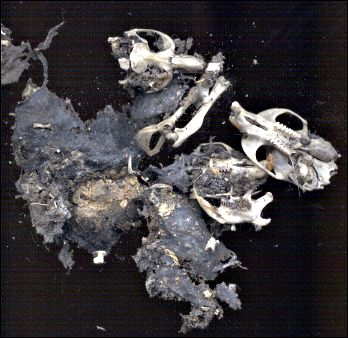

Vomiting's not an especially pleasant subject to humans. After all, it usually means that you're sick and have lost control of your body. Many animals, though, would find such an idea foreign. Some birds and mammals, for example, find the stomach the handiest place to stash food items destined for their young back home. Just think of it as a self-contained knapsack. For others, it's a part of normal dining.
The owls do this better than anyone. With little or no preparation possible, a food item is usually swallowed whole. Now, roughage in the diet is something we all need, but fur and bones are a bit much—even for an owl. Thus, these symbols of wisdom are smart enough to merely digest away the goodies and, rather than passing the remnants through the system, just regurgitate a tidy little bundle, neatly packaged.
These owl pellets are a gold mine, so to speak, to wildlife researchers
and paleontologists—a treasure trove gathered together into one little patch from
far-flung desert landscapes.

Contributor: Arthur H. Harris, Laboratory for Environmental Biology, Centennial Museum, University of Texas at El Paso.
Desert Diary is a joint production of the Centennial Museum and KTEP National Public Radio at the University of Texas at El Paso.

A portion of an owl pellet that has been torn apart to show its makeup. The grayish material is mostly matted fur. Scanned image by A.H. Harris. The skull parts are vole (Microtus).
Sibley, D. A. 2000. The Sibley guide to birds. Alfred A. Knopf, New York. 544 pp.